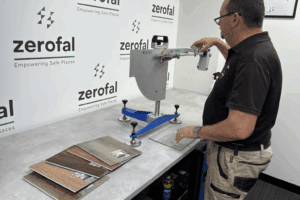Understanding D0 vs D1 in Dry Slip Testing
- AS 4586:2013 includes a dry floor friction test for surfaces always used in dry conditions.
- Results are classified as D0 (fail) or D1 (pass).
- A mean coefficient of friction ≥0.40, with no individual run below 0.35, is required for D1.
- Even one low result can downgrade a product, so D0 is not a technicality – it means unsuitable for specification.
Why dry slip testing exists
Not every surface is designed for wet areas. Timber-look vinyl, laminates, and many indoor tiles will only ever be walked on in dry conditions. For these products, the dry floor friction test in AS 4586:2013 provides a simple binary classification: D0 or D1. It ensures that even in dry settings, the surface has enough traction to be safe.
How the test works
The dry test uses a Tortus 3 Floor Friction Tester. The device travels across the sample, measuring dynamic coefficient of friction. Runs are 10cm wide. Multiple runs are taken, and the results are averaged.
The standard sets tworequirements:
- The mean coefficient of friction must be ≥0.40.
- No individual test run can fall below 0.35.
If both are achieved, the surface is classified D1. If either is missed, it is classified D0.
Why D0 matters
Some suppliers mistakenly treat D0 as “close enough.” It isn’t. D0 means the product does not meet the minimum slip resistance requirement for dry areas. It cannot be specified in compliance with the National Construction Code or relied on in handover.
Courts and insurers interpret D0 as a failure. Even if most runs were acceptable, a single low value reflects a real-world risk: one step on one part of the floor could be enough to cause a slip.
Common scenarios leading to D0 in lab test results
- Surface variation: embossed planks where flat sections dip below 0.35.
- Contamination: residues from manufacture, polish, or incorrect cleaning affecting friction.
- Inconsistencies in texture where the pattern itself is a texture – this can lead to areas which are smooth and others which are textured.
Why lab testing is essential
The simplicity of D0/D1 can be misleading. Without testing, it is impossible to know which side of the threshold a product will fall. Because one low run can change the outcome, only NATA-accredited testing provides confidence that the classification is reliable.
D0 vs D1 is not a minor detail. It is the dividing line between compliance and failure for dry-use products. For suppliers, certifiers, and builders, understanding the threshold – and insisting on accredited reports – is the only way to ensure defensible specifications.
If you supply or specify surfaces for dry use, don’t leave compliance to chance
Zerofal provides NATA-accredited dry slip testing to AS 4586:2013 with clear, defensible results.
Explore more

Colour, Grit and Surface Finish: How Subtle Differences Change Slip Ratings (AS 4586:2013)
Colour, grit and finish change slip resistance. Learn why P-ratings vary across tile ranges and coatings

Why One Slip Test Isn’t Enough for Product Lines (AS 4586:2013)
Slip resistance varies across colours and finishes. Learn why one AS 4586 test cannot certify an entire product line.

Industrial Slip Resistance: Dust, Boots & Coating Drift (AS 4663:2013)
: Industrial floors change fast. Learn how dust, coatings and machinery reduce slip resistance and why AS 4663 onsite testing is essential.
